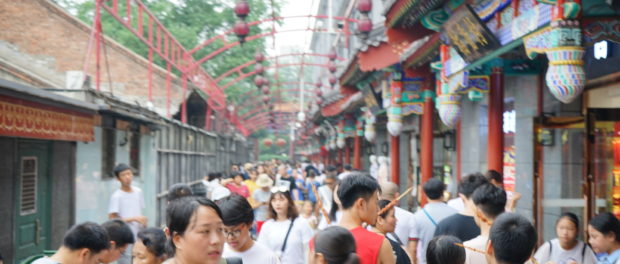Travelogue: China Part I
by Philippe Canning
Beijing –
Day 1
Greetings from the People’s Republic of China’s well monitored air space. We have already left Beijing and we are now flying to Hong Kong
This voyage is taking us to China. Yes, I know that although technically, Hong Kong and Taiwan are part of China, they are in fact not. The independently governed special administration territories have they own set of rules, their own currency and are considered foreign territories when you leave mainland China.
We start our journey in Beijing. The direct flight from Montreal to Beijing, lasting a little over 14 hours was uneventful for the most part except that they did not provide Corinne’s special meals for her allergies. I had nonetheless spent more than one hour on hold with the airline and then with the booking agency to ensure that the meals would be ok, to no avail. The very kind Air China staff went beyond the call of duty. They went through the first-class galley and found some choices that were suitable. One flight attendant even went as far as giving up her personal meal to accommodate Corinne on her second meal. First taste of China: beef noodle soup and dumplings.
We arrive at our hotel at close to 7 pm after the long journey. We are staying at the Peninsula Beijing in the Wangfujing district. It seems that the hotel administration was so happy to see us brave Canadian tourists that decided to come despite all the political tension between our nations that they automatically upgraded us to a fancy suite, instead of the regular room we had booked. We were happy to find out the great news at the front desk but our jaws dropped when we reached our suite. Hell, the place is literally bigger than our apartment in Montreal. It had a full size bedroom with king size bed, a full size living room with a couch, a dining room with seating for eight, an office area, a full size bathroom, a powder room, a dressing room, a walk-in closet, three television sets, six telephones and many more features that I missed in the four days we were there. We checked the hotel website to find out how much the hotel suite was and we were left absolutely dumbfounded: $1,400 per night!. In Canadian dollars!
Beijing is a very large city, with 21 million souls crammed into a space that seems roughly the size of the Metropolitan region of Montreal. The sea of concrete seems to go on forever. It is like downtown Montreal all over. There are people crowding the sidewalks everywhere and heavy traffic is constant, no matter where we go.
We quickly settled in and immediately set out to find something to eat. We walk along the main shopping artery of Wangfujing street and find a cross street that was lined with a few local restaurants. We walk in the first one we see. Obviously, we were the only Westerners in the restaurant and my Mandarin is as good as their English: nil. So with some pointing and gesturing, I managed to order some steamed buns with some kind of meat inside, a couple of side dishes of vegetables and a bowl of yellow broth, origin unknown. Not the most delicious way to start our culinary tour of China but good enough for now. We quickly return to the hotel, unpack our stuff and set off to bed in our immense suite.
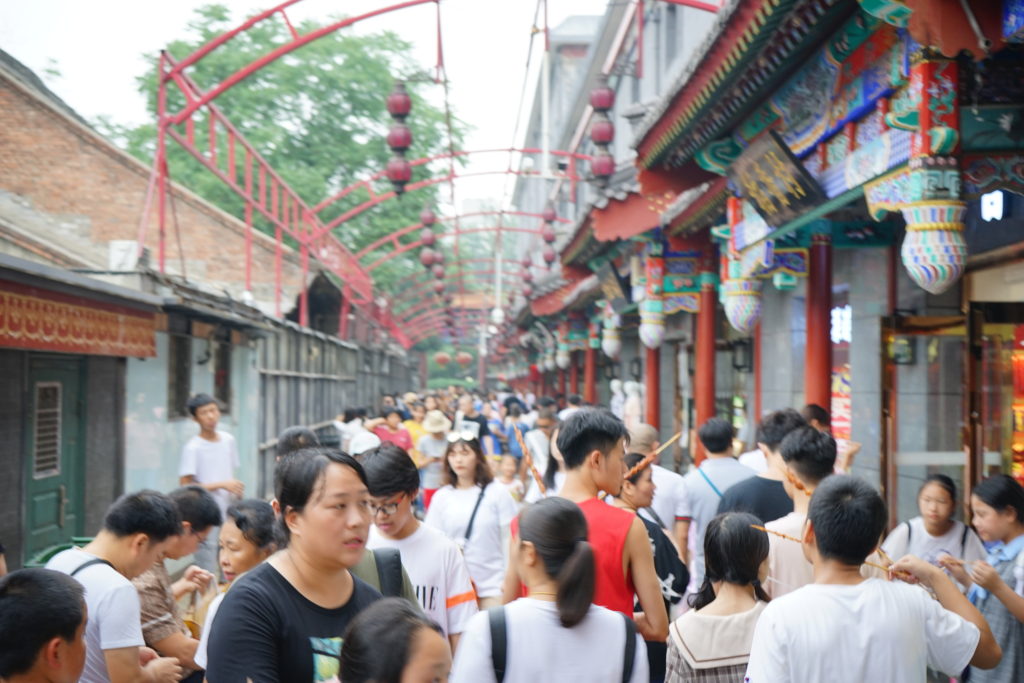
Beijing –
Day 2
On our first full day in Beijing, we hired a taxi to take us to the Great Wall of China, northwest of the Capital to visit a sector known as Mutianyu. The drive is about 1 hour and 30 minutes but the taxi seems to be the better choice. There are several other options ranging from the ubiquitous tour bus to the private chauffeur and guide. The tour bus is much cheaper but you are crammed into the coach bus with 40 or so other tourists and are forced to go through the whole visit by making a neat straight line behind the guide, with the long stick, etc… Not for us. We like to follow our own pace. The hotel also suggested a private tour with hired driver and English guide. At more than $700 including lunch and admission, we found this to be a little too pricey. Hiring a taxi for the whole trip, including a stop at the Summer Imperial Palace cost us a little over $200 which was more than reasonable. We could spend as little or as much time as we wanted at each location as the driver patiently waited for us.
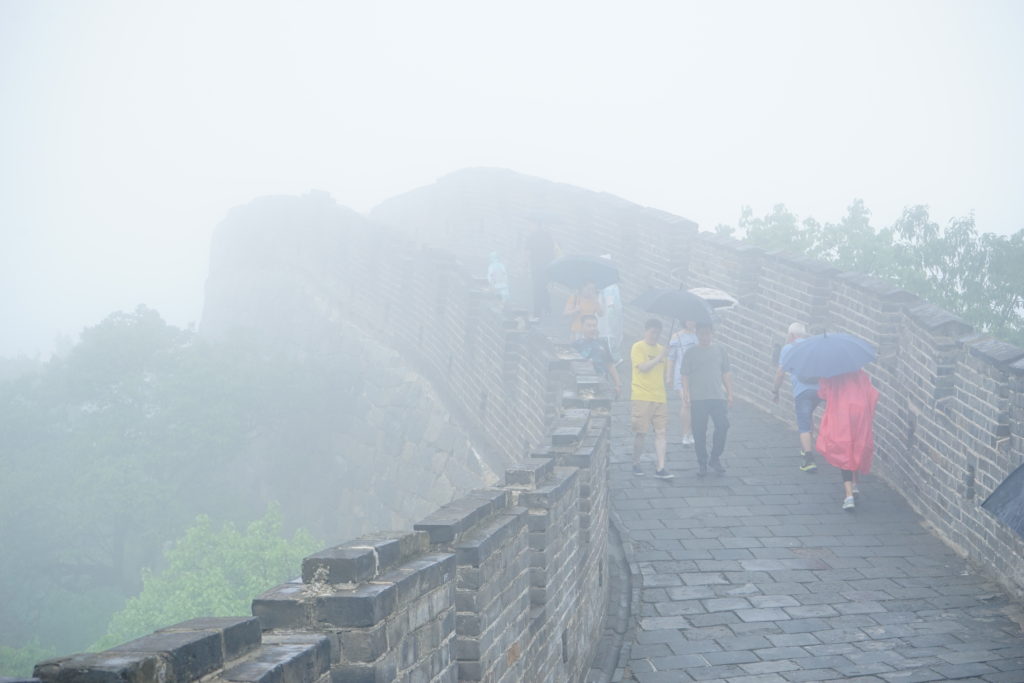
The Great Wall was a Great Deception. Our usual bad luck with weather followed us all the way to China. The clouds were literally at the same level as the hilly terrain where the wall snakes around the country side and visibility was poor to nil. After getting to the welcome centre we hopped on the shuttle bus that took us to the cable car terminal. Already the fog was so thick that we could not see the cabin ahead of us. When we finally reached the destination and finally accessed the footpath that sits atop the actual wall, we could not see 20 feet in front of us. As you can see from the pictures I am sending with this entry, we could neither appreciate the views from the wall nor could we enjoy the meandering structure that sits above the hill tops. Great Deception indeed.
We hurry back to the car and set out to our second destination, the Summer Imperial Palace. On this Saturday morning, the Palace is buzzing with people. Mostly Chinese nationals visiting the site and a few Westerners. The Palace is a succession of ornate buildings and constructions meant to cater to the Emperor’s needs during the summer months. The site is dominated by a huge lake which is surrounded by covered walking paths, temples and other quarters for the Emperor and his household. It would take several hours to be able to visit every single part of the Palace but the walk along the lake shore is quite pleasant. There are also many vessels that the visitors can use to explore the lake.
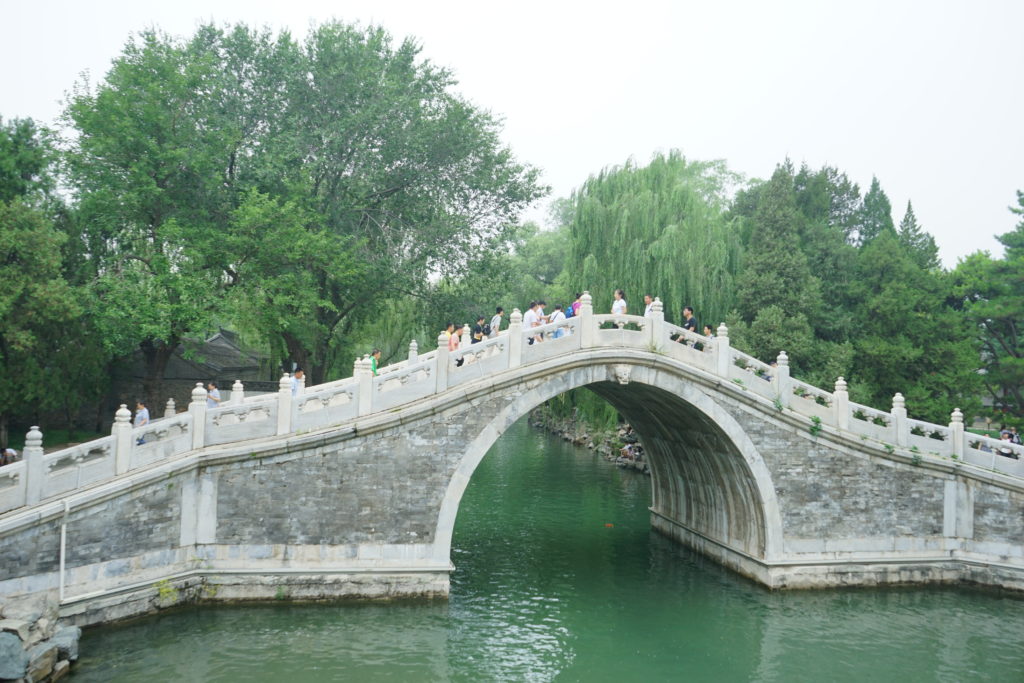
By the time we get to the Palace it is well past noon and our light Chinese breakfast we had at the hotel around 6 earlier that morning has long since been burned up. We were famished. We find the first place where they serve food and order each a plate. Corinne has some noodles with pork and I have some kind of beef stew with rice. I said that we did have a Chinese breakfast at the hotel but we are not kidding ourselves. The toned-down version for Westerners, made up of noodles, rice porridge and a few dumplings was hardly authentic. We have definitely not been lucky yet.

We return to the hotel and finish our day wandering about Wangfujing street. We find the Night Market spot, near the Beijing Department store. We find a nice little terrace and finish our day with a few drinks.
For dinner, we have reserved at Nobu. I know… Japanese inspired cuisine in China? It is sort of a tradition for us. We try to visit the Nobu restaurants in every major city we can find one in. So far, we have tried Nobu in NYC, Tokyo and Manilla. We are seated and ask for water. They bring us a bottle of still water. Then we open the menus. Nobu is a pricy restaurant but the prices in Beijing are absolutely crazy!! A meal at Nobu comprised of our favourite dishes would have cost well over $600 CDN. We get up and leave, not without having to pay for the bottle of water: $16 CDN. What a rip-off. We are sort of stuck here. We used a taxi to get here and we have no idea where we ended up. We look for other restaurants but we cannot find any. We wander to the street and walk into the first place that seems half decent. We sit down and take a look at the menu. Would you believe that we ended up in Jackie Chan’s restaurant? Yes, after all this trouble, we end up in a commercial restaurant serving mainly specialties from Hong Kong. We don’t have much choice anymore, we are famished and we are nowhere near any other decent place. We have some pan seared goose liver which was actually quite good (much like the seared foie gras), some spicy shrimps, some bland steamed vegetables and broken up chicken wings. Our introduction to Chinese authentic cuisine is a disaster. We hope to improve tomorrow
Beijing –
Day 3
We get up extra early to go for a quick work-out at the hotel gym, which was very well-equipped. Special thanks to Marc-Antoine for having devised such a painful and excruciating work-out routine that took as little as 45 minutes to completely tire us out. After a quick shower we were ready to try the traditional Chinese breakfast suggested by the hotel concierge. We find a first restaurant mere meters away from our hotel and we get in line in front of the counter where the kind Chinese lady awaits to take our order. The set up looks like any fast food chain. You give your order at the cash, pay and pick it up a little further down on the side. That is where the similarities end. We only have a general idea of what we are about to eat from the pictures on the wall in front of us. Communication is only possible by pointing and making shapes with our hands to mimic the items that we wish to order. The total on the cash is useless to us because it uses the Chinse numerals. The attendant has to punch it on a calculator so I can read the Arabic numbers and hand over the cash. Total cost: under $10 CDN. What we managed to score: 2 pieces of deep-fried bread, 2 large steamed buns with mystery ground meat, one soup with wonton style dumplings, mushrooms and other non identified items and another gelatinous soup with what looked like soy bean curd and pungent mushrooms. Corinne couldn’t have any of the soups because there was egg in them so I ended up eating both of them. Frankly, this breakfast beats eggs and bacon any day. I love having soup in the morning.
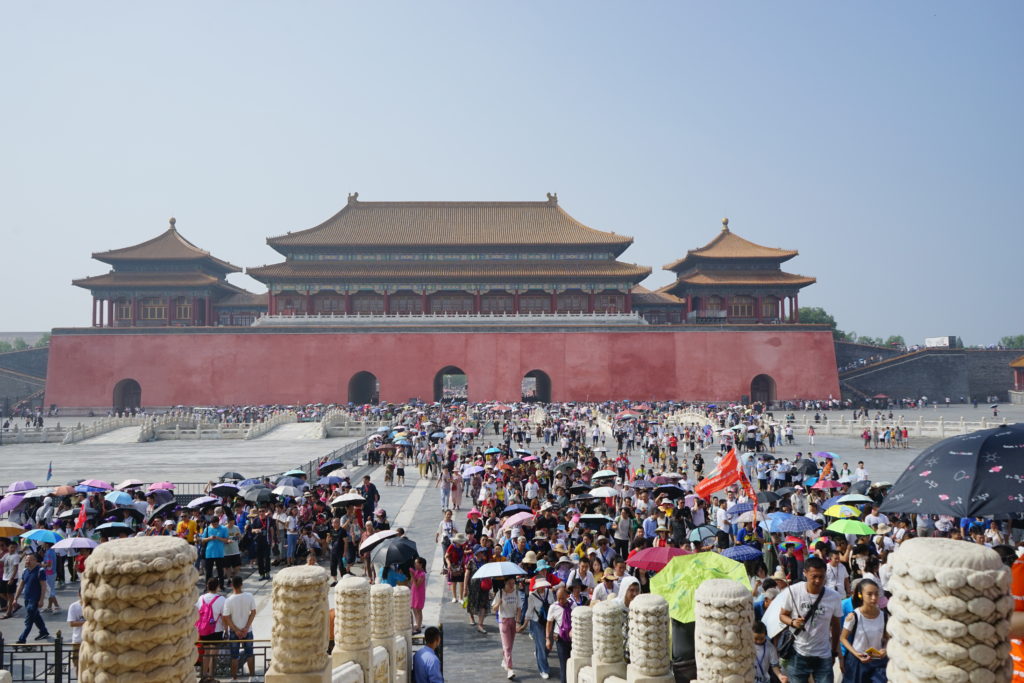
We head straight away to Tiananmen Square and the Forbidden City. We had purchased the tickets upon our arrival at the hotel. They go fast so you’d better book them in advance. The concierge entered out passport numbers which would later be used to retrieve the ticket. Cost: $24 CDN for both tickets to the Forbidden City.
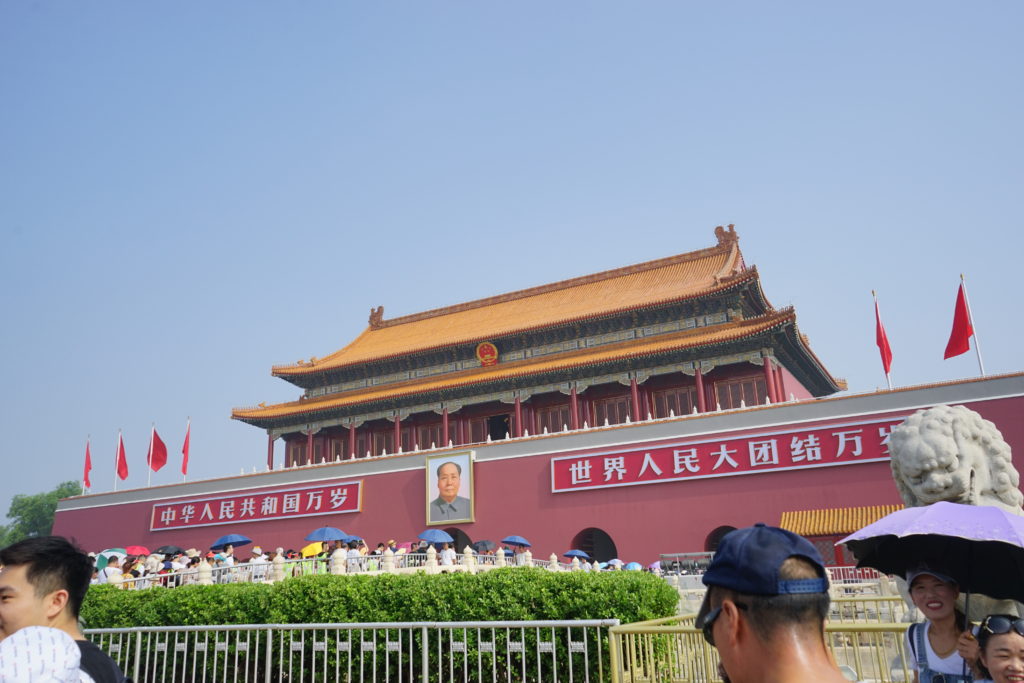
This is good time to talk about security and surveillance in Beijing. In general, Beijing seems to be one of the safest cities we have ever visited. There are armed and unarmed police officers, soldiers, security guard, militia and countless other sentinels that I cannot identify at every street corner, crossing, monument, building, outhouse, backhouse and flagstaff in the City. You cannot walk 100 meters without seeing one. All standing at attention or patrolling their immediate vicinity. I can understand why they are so disciplined. You are watched in Beijing, you are always under surveillance. There are cameras everywhere. On the buildings, on the monuments, on the light poles, hell they even have special security stations equipped with multiple cameras. They do not have food truck in Beijing. They have video trucks. To get to Tiananmen Square and the Forbidden City, you must present your passport at the security check-in on the sidewalk leading to both sites. They also x-ray your bags. This operation will be repeated at the Forbidden City entrance. They will confiscate your lighter if you have one!!
The Forbidden City is a vast expanse that once housed the Emperor and his Court. The site is accessed by the South Gate and you can only travel one way to the North. The trek will take you 1.5 km from gate to gate. There are several very large ornate buildings that you can visit. Some of them have special exhibits and collections to see. We stick to the outdoor portion. By the time we have made it to the Forbidden City which was completely packed with people, the temperature had reached 33°C or so, on to a maximum of 38°C, without factoring in humidity. We had no intention to be crammed inside any of these old monuments. The site is somewhat monotonous. The last third is the most interesting part, especially the Imperial gardens near the exit.
After the visit, we walked back to the hotel. We had already walked about 15 km by then and we were famished. We tried a hot pot restaurant. The concept is fairly simple. You order the hotpot and choose your broth. I suggest half and half. Spicy and not spicy. You get some accompanying sauce that you mix with fragrant herbs and you order the meat and vegetables that you want to cook in the broth. We chose some ribeye beef, some large shrimp, sweet potatoes and Chinese cabbage. You then soak your food in the broth and wait for it to cook through, dip in the sauce and gobble down. I enjoyed the experience very much, Corinne a little less. I have to admit that the beef was a little on the tough side and that the boiling hot shrimps were quite a challenge to eat.
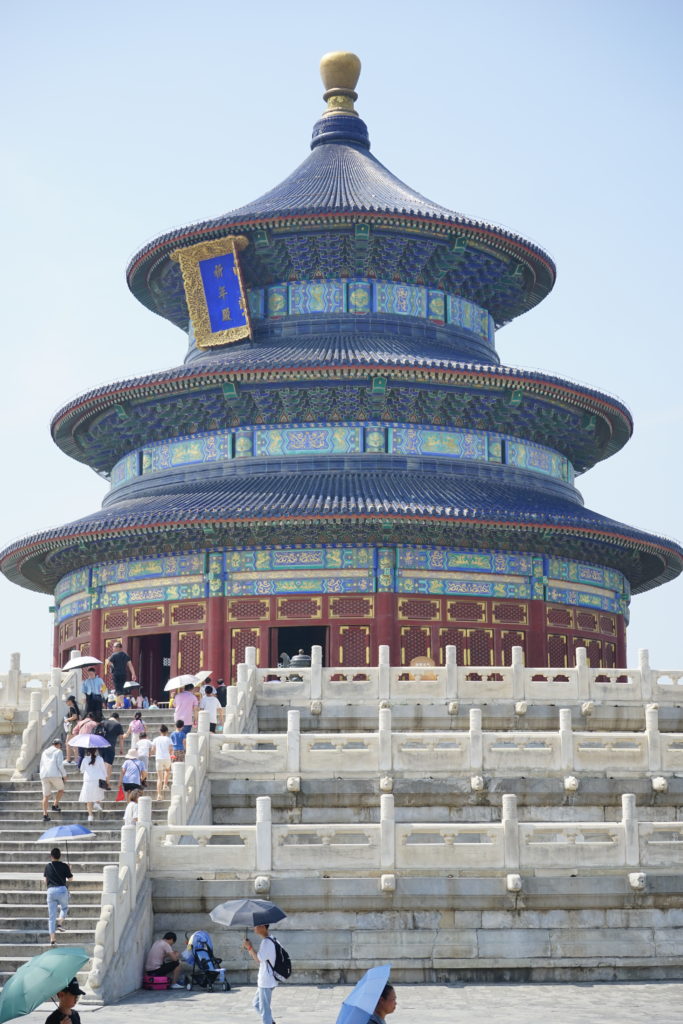
We had one last site to visit on our list, the Temple of Heaven. Located near the “old” part of Beijing, we rode a cab to our destination. The sun was pounding high above our heads and the “feels like” reading on our phone was approaching the 45°C mark. The temple is located in a pleasant garden surrounded by other smaller buildings. There were some exhibits but again we stuck to the outdoor features, concentrating on the tall cylindrical structure located towards the rear end of the park. Its ornate interior is not accessible but can be viewed from one of the perimeter openings. Truly breathtaking and quite worth the trip. We head back to the hotel in a cab that I managed to snatch in front of the waiting tourists. Taxis are hard to find in Beijing and none of them follow the actual rules. They simply refuse to use the meter. They quote a price based on your destination. You offer half the asking price and haggle your way to an agreement which ends up being 60% to 70% of the initial price. Your best bet is to find a hotel and ask the doorman or attendant to call you a taxi. They will always find either a regular taxi or one of the fancier black car services. Usually the attendant will let you know the approximate fare (from the app that he is using) and will insist on the driver to use the meter.
Now is also a good time to discuss traffic rules in Beijing. To sum it up: there are none! A pedestrian is about as important as a piece of litter in Beijing. Crossing the street when the “Walk” signal is on is perilous to say the least. Crossing on the “Don’t walk” is suicide. Red lights mean nothing to traffic that is turning right. They don’t even slow down for the pedestrians. The cars turning left on a green light cut off the vehicles traveling straight in the opposite direction. We have seen so many near misses that I wondered why we did not witness any fatalities.
After freshening up we head for dinner. Our trusted concierge has made reservations at 1949 – Duck the Chine. We are about to experience the Peking roast duck. The restaurant is well within walking distance from our hotel. The décor is modern and pleasing and the ambiance upscale casual without being too stuffy. A whole roasted duck will run you around 60$ CDN and is served with condiments. It will be enough for 2 as a main course but needs to be complimented with sides. We ordered some food and asked for a first course and a second course but it came all at once. The seared goose liver is a must. As delicate and savory as the French foie gras. The deep-fried mushroom resembling angel hair pasta was also a delight. Crispy like French fries but with the earthy tones of the fungus. Also sampled was Chinese broccoli, simply steamed and sweet and sour pork baby ribs. The duck makes an entrance. A gong is struck as the bird is presented to us. After making its acquaintance it is quickly dispatched on the cutting board gueridon where the expert carver uses a giant meat cleaver to extract delicate slivers of meat topped with the crispy skin. The waiter kindly instructs us on how to eat the poor fowl and we execute. You take a paper-thin crepe and set it down in your small round plate. You place julienned condiments: ginger, radish and cucumber. You dip a couple of pieces of meat in the thick soy sauce, peanut paste, sesame paste and crushed peanut combo, carefully place the meat pieces on top of the condiments and cover the whole kit with some crispy skin. You fold the crepe over the meat and onto its sides. Then you gobble the whole thing up. The experience was amazing and an absolute must in Beijing
Beijing –
Day 4
We are again up extra early and we head straight for breakfast. We find another local establishment and we are waved in by the waiting staff. I have to give to the Chinese. They have been so kind and so inviting. They have helped us with everything they could even though communication is extremely difficult. The results from the translation applications on their mobile phones ranged from the completely unintelligible to the downright funny. At Jackie Chang’s restaurant, the server’s phone came up with “this one is gone” to signify that they had run out of one item on the menu.
So we enter this place, much smaller than the previous one. No menu but the food is right in front of us and all we had to do is point. I pay: $6 CDN. What I managed to score on this outing: 8 small mystery meat steamed buns. One deep fried bread and 1 soup of gelatinous composition with chilies, noodles and some kind of fungus. Best breakfast yet.
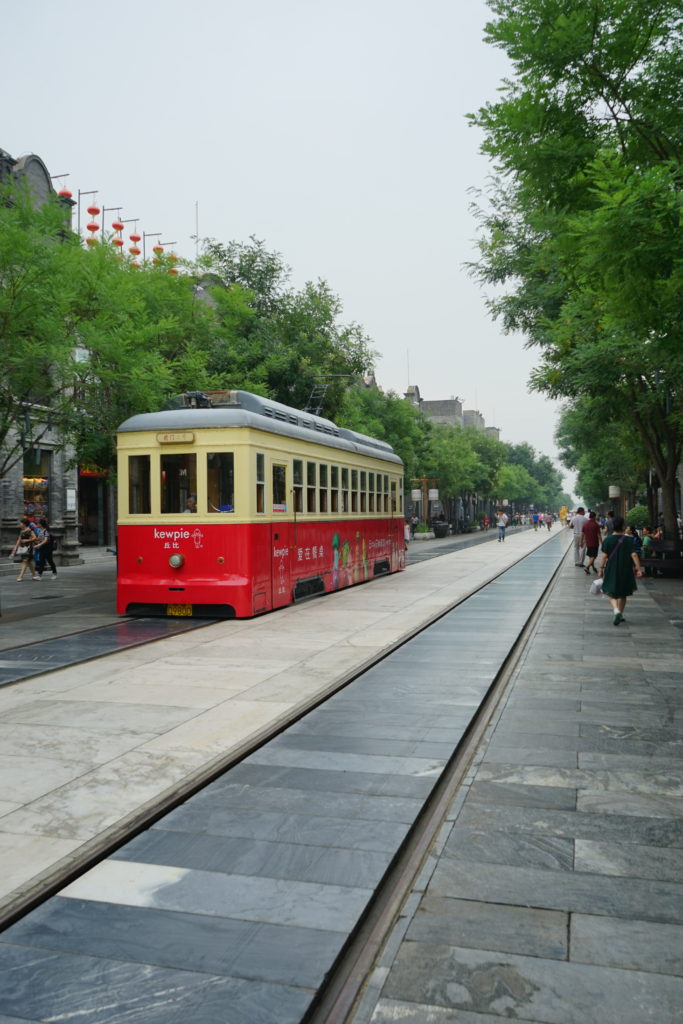
We head back in the direction of the Forbidden City, just short of reaching the Temple of Heaven and arrive at Qian Man street. This is the “old Beijing”. Well it is located on the old site of former old Beijing. Qian Man street has however been completely rebuilt in the ancient style. Nothing to do with what we were expecting but the futile attempt at reproducing and 18th century ambiance is quite awkward. However, the side streets and the back lanes are more what you would expect. The buildings and business show the wear form the years. There is even a business that has been selling silk from the 1700’s. This is however the part of Beijing we enjoyed the most. You will find all kinds of silk garments both traditional and modernized. Several artisans are also offering the fruit of their labour. There are some interesting art galleries and most and foremost, food. Lots and lots of food. Stores filled to the brim with sweets, cookies, nougat other candies. Dumplings, noodles, roast duck and so many unidentified items that we became dizzy from it all. After a bit of shopping we found a restaurant that seemed interesting. We ordered some beef noodle soup, cold noodle with sesame sauce, fried dumplings and pork and shrimp basket dumplings. The cold noodles are surprisingly refreshing with the slivers of cucumber and the rich sesame sauce, almost pea nutty but more delicate. The beef noodle soup is all about the broth. The other ingredients are simply condiments. The fragrant liquid is made up of complex flavour. I suspect a lengthy careful preparation with all sorts of bones and cartilage. It runs clear and shiny as you fish out the thick noodles with baby bok choy and beef cubes. The fried dumpling were filled with ground pork but the highlight was the crispy thin outer shell, perfectly kissed by the oily iron skillet. The other dumpling were also delicious. Light, tighly packed and achieving perfect balance between the land and sea.
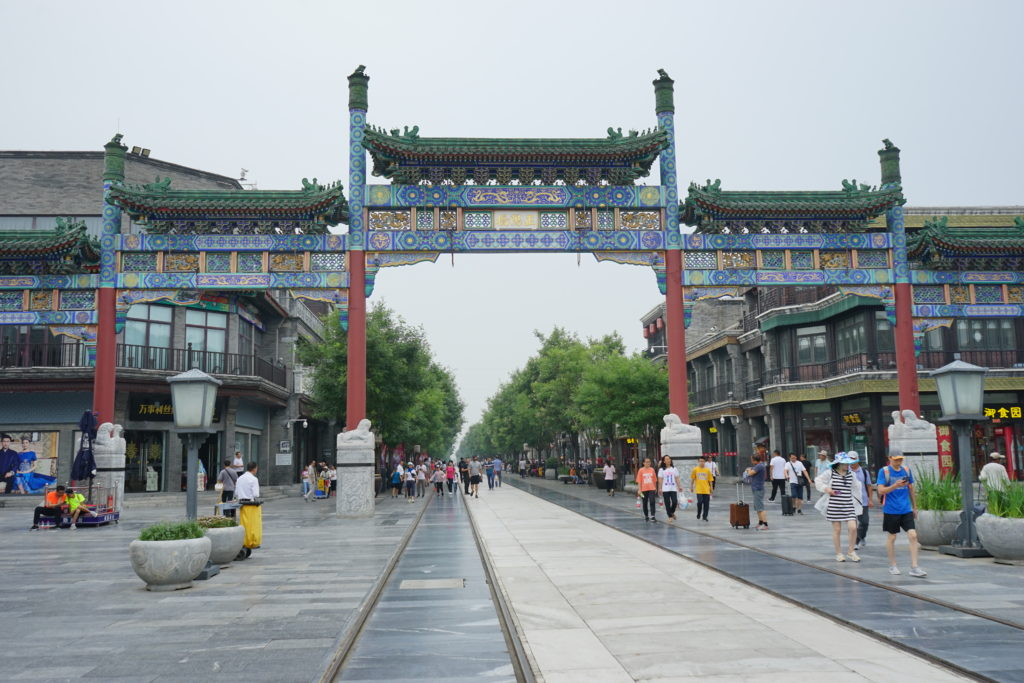
After all this food, we walk back to the hotel, not without stopping over for a drink to what has now become our Beijing hangout near Wangfujing street. Nothing of interest in terms of food, but they make a mean litchi martini.
We ask for a recommendation for our last meal in Beijing. Our concierge suggests Din Tai Fung, a dumpling place located in …. NO NO NO, I will not eat in a shopping center. There is no way. We are in China and we want to stay away from these places! The concierge insists, most restaurants in the area are located in the shopping malls (true) and the food is quite delicious (also true we will later find out). Against all our instincts and our principles, we accept. We will eat in the shopping mall. Din Tai Fung is Taiwanese in origin and is apparently famous for delicious and top quality dumplings. We order: crab pork soup dumplings, pork and shrimp basket dumplings (also with broth), half moon vegetable dumplings, mushroom dumplings (with broth) and some sides. The dumplings are much smaller than the ones we are used to in Montreal which is a good thing. You can stuff them all in your mouth and bite into them without splashing the broth all over the place. The flavors are also much more pronounced than wat we have sampled before at home and in China. They even had a decent bottle of Prosecco, which by the way is a perfect pairing for dumplings. I am happy (and quite sad) to say that we really enjoyed our last meal in Beijing in the shopping mall. I cannot wait for my colleagues at the office to make fun of me for ages. I have been advocating against shopping mall restaurants for all these years. Be advised: it doesn’t count in Asia only. Shopping malls are still evil places to eat. By the way, cost of meal was very reasonable at the shopping mall restaurant. You can expect to spend about $50 to $60 CDN for a wide selection of dumplings for 2, taxes, tip and all but before drinks.
We get back early (shopping mall diners eat early) and get to bed. We have to get up at 3 am to catch our flight to Hong Kong. Can’t wait to get there. I am sure we will not have a meal in a shopping mall in HK but you never know.
to be continued

